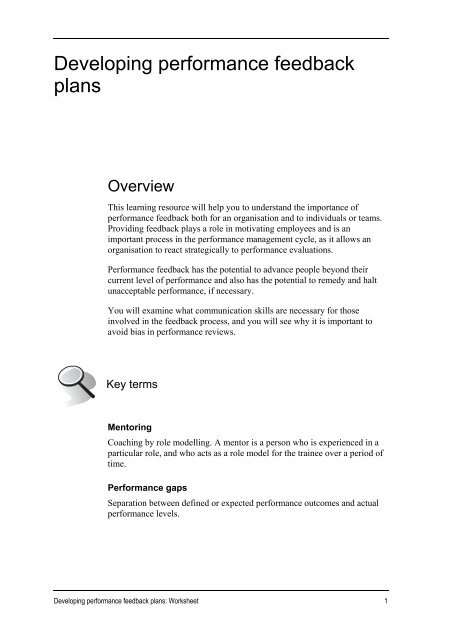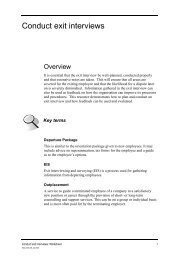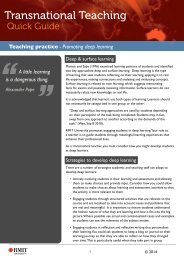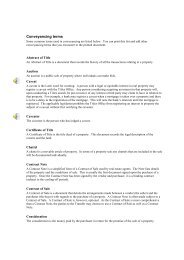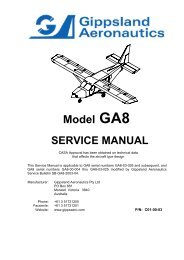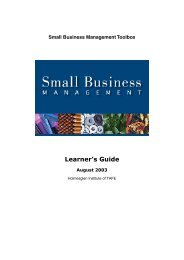Feedback plans worksheet - PDF - Flexible Learning Toolboxes
Feedback plans worksheet - PDF - Flexible Learning Toolboxes
Feedback plans worksheet - PDF - Flexible Learning Toolboxes
- No tags were found...
You also want an ePaper? Increase the reach of your titles
YUMPU automatically turns print PDFs into web optimized ePapers that Google loves.
Develop performance feedback <strong>plans</strong>Performance feedback, both negative and positive, must be provided toemployees. It is crucial for advancing and improving organisationalproductivity.To be worthwhile and effective, feedback requires forethought, care andskill.The aims of performance feedback are to:• exchange information regarding teams and individuals meetingperformance expectations• confirm expected standards of behaviour and work• work towards closing performance gaps• identify areas for learning and development• develop learning and development <strong>plans</strong>• set new performance targets/goals• review job descriptions/position descriptionsPerformance feedback, if it is to achieve its purpose, needs to be deliveredin a constructive and positive way, with specific reference to detail, ratherthan with general comment. This detail must be checked and validated, sothat the feedback is fair and the process is considered.To generate an environment of trust and respect, you need to understandyourself and others through the use of self-disclosure and effectiveinterpersonal communication during times of formal and informal feedback.This increases your prospects for giving and receiving the correct messagesduring the feedback process. It allows you to collect sufficient and relevantinformation for making a judgement on work performance.To obtain the facts on employee performance, you need to:• break down the barriers• eliminate subjectivity• avoid innuendo, presumptions and assumptions• limit comparisonsThere are a number of factors that will assist you in this process. Whenproviding feedback, consider the following points that provide for a fairDeveloping performance feedback <strong>plans</strong>: Worksheet 3
process. These will also help you assemble factual evidence on employeeperformance:• timing• facts• relevance• frequency focusConsider the timing<strong>Feedback</strong> needs to be provided at a time and place that suits both parties. Italso needs to be given near to the time of actual performance. Theimmediacy of feedback is important. For example, if a team leader wants toreprimand a team member, then feedback needs to occur as soon as possibleafter the event, and in a private place. <strong>Feedback</strong> given months later eitherremoves or negates the message. Individuals may be unable to accuratelyrecall the details of the event.<strong>Feedback</strong> that is unable to be given close to an event needs to be recordedand noted by both parties at the time it occurs. This acknowledgement of theissue or concern makes it relevant and fair.Keep to the facts<strong>Feedback</strong> must be supported with facts. For instance, while a verbalreprimand or a pat on the back may be informal feedback, it is unfair if thefacts are not evident (stated) to the person receiving the feedback.Formal feedback that is unable to be substantiated with noted facts orevidence is inadmissible in a legal arena.Keep it relevant<strong>Feedback</strong> needs to be relevant to the performance and the performanceability of individuals. <strong>Feedback</strong> on a role relationship problem between twopeople is inappropriate when it is an interpersonal relationship problem,rather than a recognised role relationship.While this may still pose a workplace problem, the feedback needs to take adifferent approach, eg, focused on the impact that this problem is having onwork tasks or work colleagues. If there is no work-related reason to addressthis problem, then feedback needs to state that up-front.4 Developing performance feedback <strong>plans</strong>: Worksheet
Consider the need for frequencyThe frequency of feedback needs to take into account the above factors, andwill be determined by the need for immediacy, timeliness and relevance. Itcan be given now, tomorrow, next month, or at the end of a formal periodset by the organisation.Informal feedback tends to be on-the-job, immediate and frequent. Formalfeedback may be less urgent, less frequent, and at predetermined times andlocations.Stay focused<strong>Feedback</strong> must remain focused on the performance being addressed. It is acommon error for both parties to stray onto unrelated or side issues. Beaware of this, and if the focus shifts, refocus back to the performance matterbeing addressed in the feedback session.Planned formal feedback sessions have the advantage over informalfeedback in that you can take these elements into account and plan for them.With informal feedback you do not have the benefit of foresight. Practisethese elements at all times in your daily routine as you give feedback, suchas giving a nod of agreement or a word of correction. Practise a fair andeffective exchange of information on the performance of the other person.Formal review sessions need to be organised and conducted with anenvironment that facilitates honest and open feedback. Have each personinformed of the date, time and location and conduct the session in a quietand private place. Allow adequate free time for both parties to providefeedback.Have the required documents for review, supporting evidence onperformance achievements, and organisational forms to record the results ofreview and feedback. In addition, assemble the forms that will be used forplanning future performance, for planning improvement and development,and for recording any performance interventions that have been identified.When there are interruptions, or when either party is too busy to be able tofocus on the task at hand, then feedback is likely to be distorted. Thefeedback stage is as likely to be rendered unfair and invalid, as with anyother stage of performance management systems, if it is not planned andconducted skilfully with a view to providing a fair, constructive andproductive process.Developing performance feedback <strong>plans</strong>: Worksheet 5
ReadRecommended additional reading on feedback and self-disclosure, andthe giving and receiving of feedback, can be found in Communicatingfor Team Building by Baden Euson, on pages 70–80.<strong>Feedback</strong> with trust and respectOpen channels of interpersonal communication engender trust. Closedchannels of communication breed mistrust. Managers speak of an “opendoor” style of management to encourage employees’ trust. Governmentsspeak of being open and transparent to gain political trust, and companiestalk of opening their “books” for scrutiny in the hope of fostering trust.How then do people at work create trusting relationships among themselves,in a way that allows for honest and fair feedback to take place?ThinkConsider the attributes of people whom you trust. Sometimes this isimmediately obvious to you, sometimes it takes time and experience withthat person. Likewise, some individuals are slow to trust, while others trustmore quickly.Try itIdentify qualities of trust that facilitate the giving and receiving offeedback.The following points identify some of the qualities that create trust. Useexamples from your own work experience of these qualities in people youknow, then respond with feedback that will in turn create a reciprocalrelationship of trust.6 Developing performance feedback <strong>plans</strong>: Worksheet
1. Someone who says ’hello’ every time they see you.Would you respond? How would you respond? Would you give themfeedback on how much you appreciate or reject their daily greeting?_______________________________________________________________________________________________________________________________________________________________________________________2. Someone who tells you they have made a mistake.What would be your response to them when they tell you this?_______________________________________________________________________________________________________________________________________________________________________________________3. Someone who asks you how you are going in your job.How would you respond?_______________________________________________________________________________________________________________________________________________________________________________________4. Someone who always keeps promises.Would you give this person feedback on how this enables you to trust them?_______________________________________________________________________________________________________________________________________________________________________________________5. Someone who gives you positive reinforcement, such as “I like the wayyou do that”, or “I like your style of writing”.How would you use your body language to give feedback in this instance?_______________________________________________________________________________________________________________________________________________________________________________________Developing performance feedback <strong>plans</strong>: Worksheet 7
6. How would you know (from verbal or non-verbal feedback) thatsomeone:(a)is being honest with you?_______________________________________________________________________________________________________________________________________________________________________________________(b)is sincere in what they say?_______________________________________________________________________________________________________________________________________________________________________________________(c)trusts you?_______________________________________________________________________________________________________________________________________________________________________________________(d)respects your views or opinions?_______________________________________________________________________________________________________________________________________________________________________________________Communicating feedbackInterpersonal communication skills that are particularly relevant to givingand receiving feedback are: active listening, appropriate questioning,reflective listening, and reframing and paraphrasing.Active listeningActive listening means indicating to the other person that you are with themby:• maintaining eye contact• turning your body towards the other person8 Developing performance feedback <strong>plans</strong>: Worksheet
• inclining your body posture towards the other person• body movements that respond to what the other person is saying, such asan opening of your hand, a head nod or a shoulder shrug• facial expressions that respond to what is being said, such as a smile orgrimace, a raised eyebrow, a tightening or relaxing of the mouth• using verbal encouragers, such as “okay”, “I see”, “right”, “mm”, “ahhaa”, or “go on…”• responding verbally or non-verbally to questionsQuestioningQuestioning is an essential component of formal and informal performancefeedback. Questions in a performance feedback situation are used to:• confirm performance actions and results• determine the degree of performance achievement• identify performance gaps• draw out underlying concerns, conflict and grievance• check understanding and misunderstanding• reinforce directivesQuestioning is an interpersonal skill that needs practice, both in the types ofquestions used, and in relation to the appropriateness of questioning toaddress particular situations.Sometimes you want a straight “yes” or “no” answer, while at other timesyou want more of an explanation. Ask a closed question, such as “Did youdo that?” and you will receive a single word answer. Ask an open question,such as “Can you tell me how you did that?” and you will get anexplanation.At other times you want to ask a question that clarifies a point, such as “AmI right in assuming that you want to refocus your attention on this project?’or “Are you saying that no-one believes you?”Often during individual and team performance planning situations, feedbackrequires stocktaking questions to check or confirm progress, such as• “Where do we want to be?”• “How much have we achieved?”Developing performance feedback <strong>plans</strong>: Worksheet 9
• “Have we met our time lines yet?”A question such as “Can I leave it to you to put that on the Action Plan?”propels the action forward by putting the onus for action on the personasked.There are probing questions to ask when you want to look further intoactions, behaviours and attitudes that are vague or inexplicable. You maywant to explore behaviour with “Can you explain to me why you did that?”Or, you may want to explore a belief with, “Can you give me instances thatmight explain why you believe Mary is conducting a vendetta against you?”To determine why a goal has not been achieved, you may ask, “In the lightof these results, do you think your output target was too high?”.Remember when you are questioning to stay focused on the performance orbehaviour in question. Limit the amount of repetition you use, becauserepeated questioning can be threatening. For instance, to repeatedly ask“Did you take it to Jim? Did you?” (as your voice gets louder and firmer).This can shut down communication. Rephrasing your question will oftendraw a response, especially if you can give a reason for your question. Forexample:• “Did you take it to Jim?”• “I just need to know whether you took it to him or not.”• “Mary, it really is important that I know.”To accompany and complement questions in your efforts to get to the cruxof a matter, you may use:• reframing, such as “Let me put it another way”.• paraphrasing, such as “So what you are saying is that you don’tunderstand what to do in those situations”.• reflective listening, such as “Yes, I can see your point”.These techniques help obtain information that is not always clear orimmediately evident. It may help you to reiterate or confirm facts orunderstanding for yourself and the other person.You could, for instance reflect on the feelings being shown by Mary with“You seem reluctant to tell me whether you took it to Jim or not”. Thisreflection needs to be accompanied by sincere body language and a softertone of voice that indicates your show of empathy or concern. If Mary says“Yes” or nothing, you could pursue this with “Would you like to tell meabout it? It seems to be worrying you.”10 Developing performance feedback <strong>plans</strong>: Worksheet
ReadRecommended additional reading on active listening, questioning andreflective listening for providing performance feedback can be found inthe following two texts:Communicating for Team Building by Baden Euson, on pages 80–89.Managing Performance Improvement by Tovey, on pages 285–295.So far you have explored some of the issues and elements of feedback thatwill facilitate your effort to provide a fair, constructive and productiveprocess, and which will obtain true and detailed facts. This applies as muchto the planned formal process, as it does to informal day-to-day feedback onwork performance.Performance management systems enable formal and informal feedback tobe provided for teams and individuals at any point during the employmentperiod, as illustrated below in Figure 12.Figure 12 Performance feedback as an added cyclical process in the cycle ofperformance managementplanningcoachingcoachingfeedbackimplementingcoachingcoachingreviewingDeveloping performance feedback <strong>plans</strong>: Worksheet 11
Performance feedback <strong>plans</strong>The <strong>plans</strong> that are developed for conducting formal performance feedbackare integral to performance management systems. You identified thispreviously. Figure 13 is an extract from Figure 6 which illustrates howformal performance <strong>plans</strong> emanate from performance review, and precedeperformance development and improvement.Figure 13 Extract of performance management, highlighting performance feedbackFigure 14 serves as a reminder of the inclusiveness of performance reviewand feedback activities in performance management systems, and the needto plan for feedback with organisational, team and individual performanceachievements in mind.12 Developing performance feedback <strong>plans</strong>: Worksheet
Figure 14 Performance Management System, highlighting the function ofperformance review and feedbackReview of formal performance feedback <strong>plans</strong>Formal planned performance feedback needs to take into account theorganisation’s requirements, which you explored previously. These includeapplicable policies, procedures, standards and legislation.Formal employee performance feedback processes for satisfyingorganisational requirements are determined by the organisation. There may,for example, be policies and procedures in place that explain who providesperformance feedback and how and when it is provided.Developing performance feedback <strong>plans</strong>: Worksheet 13
ThinkAre there policies and procedures relating to performance feedback inyour organisation?The following is an example of the performance development and reviewprocess undertaken by the Open <strong>Learning</strong> Institute, in which feedback isprovided at a number of points throughout the process. The notable pointsof feedback by the employee to other people are at boxes 7, 25, 16, 15, 14,26 and 27. There are also points for self-feedback at boxes 2, 3 and 4combined; and 5, 9 and 6 combined14 Developing performance feedback <strong>plans</strong>: Worksheet
Figure 15 Performance development and review process(Source: Open <strong>Learning</strong> Institute Procedure 2002, PR-A071.04Development and Review of Personal Performance and Development Plans, 19/08/02.)Individual performance feedbackA formal, periodic, organisationally-determined, individual performancefeedback plan focuses on and addresses the following items:Developing performance feedback <strong>plans</strong>: Worksheet 15
Individuals• job description• performance objectives• action <strong>plans</strong>There are planned stages through which the performance feedback processfor individual employees proceeds. This involves:1. Preparatory feedback undertaken by the individual to:• determine what needs to be communicated regarding any changes to thejob description in relation to goals and work activities based on theduties and roles of the job description• prepare to provide feedback on the extent to which individual goals havebeen met• prepare to provide feedback on the fulfilment of individual action <strong>plans</strong>• prepare to identify new goals/objectives to meet team KRAs• prepare to develop new action <strong>plans</strong> to meet goals/objectives• identify learning and development needs for addressing performanceimprovement2. Combined feedback on performance achievements between the individualand team leader to:• critique job description and decide on any needs for change• deliberate on the evidence of goal achievement• agree on new goals/objectives for the next performance period• deliberate on action plan outcomes• agree on a further plan of action to address new goals/objectives• communicate learning and development needs• identify any interventions3. Both the individual and team leader complete all relevant documentationon feedback outcomes to:16 Developing performance feedback <strong>plans</strong>: Worksheet
• agree on a date for the next review and feedback• agree on action, signed by both parties, which will include:• new goals/objectives and <strong>plans</strong> to meet goals/objectives• any points for merit• learning and development activities• any interventions4. Problems and grievances arising from performance feedback areacknowledged and addressed by both the individual and the team leaderwith:• reference to applicable organisational policies, procedures, standards orlegislative instruments (legal or industrial)• documented evidence to support the grievance• relevant senior personnel, if unresolved• specialist assistance, if unresolvedTry itProvide an outline of the stages of an individual performance feedbackplan from your own or another organisation.If you do not have a formal feedback process as part of a performancemanagement system, devise your own feedback plan by making a list of dotpoints to indicate what has to be addressed as part of the feedback process.___________________________________________________________________________________________________________________________________________________________________________________________________________________________________________________________________________________________________________________________________________________________________________________________________________________________________________Developing performance feedback <strong>plans</strong>: Worksheet 17
________________________________________________________________________________________________________________________________________________________________________________________________________________________________________________________________________________________________________________________________________________________________________________________________________________________________________________________________________________________________________Functional team performance feedbackFormal performance feedback will also need to address functional teamperformance, whether at a time determined by the organisation, or on anincremental or needs-basis determined by the team. Team performancefeedback will emerge from a review of the following four areas:Functional/operational teams• key performance results areas• key performance indicators• performance targets• performance objectives1. A team meeting is planned for the purpose of feedback on performanceinformation/data collected from performance review, and to:• give and receive feedback to determine the degree to which team KRAs(Key Results Areas) have addressed organisational KRAs• give and receive feedback with a view to determining any need torefocus team KRAs• give and receive feedback to determine the degree to which KPIs (KeyPerformance Indicators) have been addressed• provide feedback on target/goal achievement• provide feedback on the extent to which objectives have been met18 Developing performance feedback <strong>plans</strong>: Worksheet
2. Compile an Action Planning Sheet to provide a record of:• intentions to redress team KRAs• achievement or lack of achievement of KPIs• new targets/goals• new objectives• who, when, where and how actions will be initiated and/or managed3. Enable team members to use the Action Planning Sheet to plan individualperformance by:• reviewing their job description in view of team changes• setting new performance objectives• writing new action <strong>plans</strong>The cyclical nature and continuous process of performance managementsystems means that individual performance will impact on teams, and teamperformance will impact on the individuals in the teams.There is no need for subjective informal or formal feedback, other than toknow that each individual has set new goals and made new <strong>plans</strong> formoving forward with the team, and that day-to-day feedback propelsindividuals and teams forward in pursuit of team and individual goalachievement.Train for performance feedbackYou need particular knowledge and competent skills to carry out successfulfeedback. When feedback is good, that is, when it is positive andenlightening and to the satisfaction of both parties, then feedback skillsseem less critical.However, it is at those times when you suspect that all is not well, thatfeedback is challenging. <strong>Feedback</strong> moves beyond the realm of being just achallenge at times when performance is overtly poor, that is, when theperson has done something wrong or illegal, or is under-performing, or hassub-standard work. It can be difficult to be:• empathetic while at the same time feeling angry• caring yet needing to reprimandDeveloping performance feedback <strong>plans</strong>: Worksheet 19
• failing to develop someone to what you perceive to be their fullpotential• terminate the employment of an employee who fails to meet workstandardsMost people need training to provide performance feedback.Who needs training?Anyone who is going to be receiving and giving performance feedback willneed to be competent for the task. If they are not yet competent, then theyneed training. These people will be team leaders, managers and supervisorswho are involved in the formal feedback process.There will also be people who will be expected to give and receive informalor formal feedback on a day-to-day basis. They are the mentors, counsellors,workplace trainers, team leaders and the team members who coach and actas mentors to other team members.There may be specialist staff who occasionally need to provide performancefeedback, such a quality controllers, technicians and occupational health andsafety officers. They may be working with teams and individuals incircumstances ranging from special projects to fire drills and audits.Training methodologiesThere are a number of methods that are particularly suited to training forperformance feedback. <strong>Feedback</strong> is a skill that is learned through practice.While some underpinning knowledge is necessary, the thrust of training isto address the skills required for real-life performance feedback situations.This is accomplished in the following ways:• by illustrative and interactive training with the use of videos, CD-ROMand commercially available computer training programs• by interactive practice in workshops and workgroups• by role playing• by supervised coaching and mentoring on-the-job• with a combination of any of the above, coupled with basic information(printouts, booklets, kits, videos), either beforehand or together with theinteractive training.Coaching and mentoring is best used as a complementary training activity,following a more formal comprehensive training program. You can return to20 Developing performance feedback <strong>plans</strong>: Worksheet
the role of coaching and mentoring after you have considered the formaltraining alternatives for acquiring performance feedback skills.Interactive training in any form is particularly worthwhile for skillsacquisition involving interpersonal relationships. If you are introducingperformance management systems organisation-wide, or even into a numberof functional areas, an interactive training program is a cost effective way ofpreparing a number of people at one time.Role plays, workshops and work groups can all be planned to provide theopportunity for people to train and interact with each other in simulatedperformance feedback situations. The training can also be undertaken as acombined off-the-job/on-the-job training program with the assistance ofworkplace trainers and assessors.Assessing skillsIn addition to planning the training workshop, you need to devise a meansof assessing trainee learning achievements, and evaluating the process andcontent of your training program.A competency skills checklist would be an appropriate option for individualassessment. To develop a competency check, list the skills that each personneeds to demonstrate by the end of training. Allow two columns for eachskill check.Then, either duplicate the two columns (one pair for the trainee to selfcheckand one pair for the trainer to check), or make copies of each sheet,one for the trainee to make a self-assessment, and one for thetrainer/facilitator to make an assessment.Both assessors need to answer whether the trainee “is able or unable todemonstrate the skill”.As an example, the following (part) competency checklist could includerelevant performance feedback skills checks:Table 1: (Part) competency checklist (3 cols)Trainer’s copy Is able to Is not yetable to1. Demonstrates active listening by:• maintaining eye contact• inclining towards the other personDeveloping performance feedback <strong>plans</strong>: Worksheet 21
Trainer’s copy Is able to Is not yetable to• using appropriate facial expressions• using short verbal encouragers.2. Uses questioning techniques by asking:• open questions• probing questions• reflective questions• leading questions.3. Assembles required documents for recordingfeedback outcomes which include:• new goal record• plan of action• individual job description• update sheet• learning and development <strong>plans</strong>.Coaching and mentoringFollow your formal training program with coaching and mentoring.Coaching and mentoring is undertaken by competent individuals in theworkplace, who have the ability to motivate individuals from where theyare, to where they need to be, to perform their jobs.There are a number of reasons for using coaching and mentoring. Eachaddresses new or emerging job needs, as well as updating knowledge, skillsor behaviours specific to the job. Coaches and mentors work withindividuals to provide practical, on-the-job experience and guidance.Coaching is more structured than mentoring, and is used for on-the-jobtraining, whereas mentoring is used to guide, and expands on the currentabilities of a person.Mentoring is coaching by role modelling. The mentor is a person who isexperienced in performance feedback; they act as a role model for thetrainee over a period of time. Mentoring is useful when a person has someknowledge and experience in feedback situations, but possibly needs toapply it to performance feedback in the particular organisation or functionalarea.22 Developing performance feedback <strong>plans</strong>: Worksheet
ThinkConsider opportunities for coaching and mentoring in your workplace.Identify a person, or a number of people, in your own workplace whom youwould place in a coaching or mentoring role.ReadThe recommended additional reading, Coaching, mentoring andmanaging by Holliday, addresses many of the issues for successful teamand individual performance through coaching and mentoring. Thisreading also contains a number of forms that can be used by coaches andmentors for performance assessment and evaluation.Evaluating trainingA training program evaluation entails a systematic inquiry to determine thevalue of the program, both in terms of process and content. It draws on anumber of sources to determine whether the training provided the requiredskills for selected employees to undertake performance feedback.Evaluation requires feedback on the program from the participants at theend of training. Generally, trainees are asked to complete a questionnaire orfeedback form about both the process and content of the training. <strong>Feedback</strong>is sought on the suitability of the arrangements for training, including theenvironment and training methodologies for successful learning.Evaluation also needs to incorporate collated information and analysis fromindividual assessments, in this case the competency checklists, e.g:• are there too many instances of individuals unable to perform certainskills?• are there any individuals who are unable to perform an unacceptablenumber of skills?When this information is analysed, it can provide a basis for taking action.Developing performance feedback <strong>plans</strong>: Worksheet 23
Evaluate performance managementsystemEvaluation judges outcomes, yet many organisations fail to conductperformance management evaluations. Despite the temptation to avoidevaluation, it is essential that performance management systems arereviewed. Evaluation can determine the value and worth of performancemanagement systems to the organisation.What is to be evaluated?To be effective, evaluation must be carried out in such a way that ajudgement can be made regarding whether or not the systems are deliveringwhat they are expected to deliver. The following areas need to beexamined:1. The extent to which performance management systems support theorganisation’s strategic:• mission• goals and objectives• key results areas (KRAs)2. The extent to which performance management systems empowerfunctional teams to address their:• key performance areas• key performance indicators (KPIs)• performance targets• performance objectives3. The extent to which performance management systems enable individualemployees to:• relate job descriptions to performance expectations• set performance objectives• develop action <strong>plans</strong>4. The extent to which performance management systems encourageemployee development.24 Developing performance feedback <strong>plans</strong>: Worksheet
5. The ability of performance management systems to intervene to rectifyunacceptable performance.6. The degree of difficulty in using and administering performancemanagement systems.ReadRecommended additional reading can be found in Chapter 24 “Evaluatingperformance management”, in Performance Management by Armstrongand Baron.Methods of evaluationYou can use any one or a number of the following methods to evaluateperformance management systems:• questionnaires• observation• surveys• focus groups• diagnostic checklists• audits• statistical analysisQuestionnairesQuestionnaires check the understanding, attitudes, processes and content ofperformance management systems. They can be completed by teams as acombined effort or by individuals. Questionnaires can ask straightquestions, such as “What is the business focus of your organisation?” withmultiple-choice tick boxes to answer.Or, a questionnaire can be in the form of a rating scale ranging from“strongly agree” to “strongly disagree” in answer to a statement like,“Performance management systems motivate you to perform exceptionallywell”.Developing performance feedback <strong>plans</strong>: Worksheet 25
ReadRecommended additional reading can be found in Appendix A inPerformance Management by Armstrong and Baron. This contains anumber of questionnaires that can be used to evaluate staff understandingand use of performance management systems.ObservationObservation with the use of checklists can evaluate practices andprocedures. This could be a useful method for making a judgement on teamprocesses. You can arrange with a team to observe, using a checklist toidentify and develop key performance areas, key performance indicators,performance targets and performance objectives.SurveysSurveys can be used to determine attitudes or behavioural responsestowards performance management systems or any component of thesystems, such as review processes. Similarly, surveys can be done todiscover the extent of understanding by staff of performance managementsystems or systems components.ReadRecommended additional reading can be found in Appendix B inPerformance Management by Armstrong and Baron. This providesexamples of employee attitude surveys towards performance managementsystems.Focus groupsFocus groups are structured and facilitated groups, formed for the purposeof discussing planned, open-ended questions to gain information. Suchgroups, when in the hands of skilled facilitators, are considered timeefficientand able to yield high quality information, particularly in the earlystages of research. Focus groups are a useful means for evaluating the initialintroduction, implementation and management of your systems.26 Developing performance feedback <strong>plans</strong>: Worksheet
Diagnostic checklistsUse diagnostic checklists to check all aspects of performance managementsystems. For instance, check whether:• organisational culture is ready for performance management systems• teams are sufficiently empowered to develop KRAs and KPIs• performance measures determined by an individual can be undertakenaccording to the skills of the individual identified in the job descriptionAuditsAudits are inspections and investigations. Audits can be conducted, forexample, to investigate whether ISO standards are being upheld and toassess behaviour in a client relationship. Audits can be used as plannedactivities or randomly. They may be used randomly, for example, to:• monitor progress in achieving outputs• inspect measurement tools for safety purposes• scrutinise work practices for legal complianceStatistical analysisStatistical analysis can be undertaken using computer generated data. Forexample, evaluation of legal compliance or non-compliance data recordsprovides evidence of the ability of performance management systems toreduce non-compliant behaviour or practices. The response to this would beto improve on an unacceptable record.Statistical analysis can also be used to evaluate time frames for teamimplementation of any element of performance management systems. Thiscould provide evidence that indicates a need to work with teams strugglingwith timeframes.Statistical analyses can also be used to evaluate the ability of performancemanagement systems to address individual performance.Consider statistics compiled for performance learning and developmentactivities on employees. Are there reductions or additions to the number ofindividuals activity engaged in tertiary study programs on a year-by-yearbasis? If so, should an effort be made to improve on this and for whatreason?Adapted from Open <strong>Learning</strong> Institute (2003) Learner's GuideBSBHR503A TAFE QLD; used with permissionDeveloping performance feedback <strong>plans</strong>: Worksheet 27


